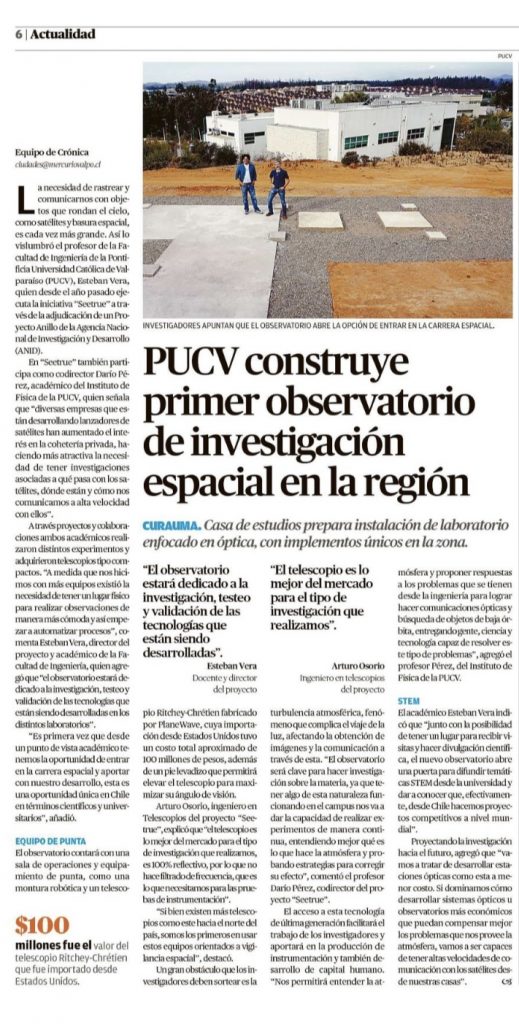On Saturday, April 30th, the regional newspaper published an article about the observatory we will install at the Curauma Campus of PUCV.
In the article, professors Esteban Vera and Darío Pérez, along with our telescope engineer, Arturio Osorio, highlight the relevance of the observatory installation and the SEETRUE project by explaining details about it.

We appreciate the dissemination of this news, which is a milestone for our University and also for the development of space research with a focus on optics. You can check out the complete article below:
PUCV builds the first space research observatory in the region

Curauma. The university is preparing to set up a laboratory focused on optics, with unique equipment in the area.
The need to track and communicate with objects in the sky, such as satellites and space debris, is increasingly significant. This was envisioned by Professor Esteban Vera of the Faculty of Engineering at the Pontificia Universidad Católica de Valparaíso (PUCV), who has been leading the “Seetrue” initiative since last year through the award of an Anillo Project by the National Agency for Research and Development (ANID).
Darío Pérez, co-director of “Seetrue” and an academic at the Institute of Physics at PUCV, states that “various companies developing satellite launchers have increased interest in private rocketry, making it more attractive to conduct research on what happens with satellites, where they are, and how we can communicate with them at high speed”.
Through projects and collaborations, both academics have conducted various experiments and acquired compact-type telescopes. “As we obtained more equipment, there was a need for a physical location to conduct observations more comfortably and begin to automate processes”, comments Esteban Vera, project director and academic from the Faculty of Engineering, who added that “the observatory will be dedicated to research, testing, and validation of technologies that are being developed in various laboratories”.
“For the first time from an academic perspective, we have the opportunity to enter the space race and contribute to our development. This is a unique opportunity in Chile in scientific and university terms”, commented Esteban Vera, an academic from the Faculty of Engineering.
“The observatory will be dedicated to research, testing, and validation of technologies that are being developed”.
Esteban Vera
Professor and project director
CUTTING-EDGE EQUIPMENT
The observatory will feature an operations room and cutting-edge equipment, such as a robotic mount and a Ritchey-Chrétien telescope manufactured by PlaneWave, whose import from the United States had an approximate total cost of 100 thousand dollars, in addition to a lifting base that will allow the telescope to be raised to maximize its field of view.
Arturo Osorio, the telescope engineer for the “Seetrue” project, explained that “the telescope is the best on the market for the type of research we conduct, it is 100% reflective, so it does not filter frequency, which is what we need for instrumentation tests”.
“While there are more telescopes like this one further north in the country, we are the first to use such equipment oriented towards space surveillance”, he emphasized.
“The telescope is the best on the market for the type of research we conduct”.
Arturo Osorio
Project Telescope Engineer
A major obstacle that the researchers must overcome is atmospheric turbulence, a phenomenon that complicates the journey of light, affecting the acquisition of images and communication through it. “The observatory will be key to conducting research on the matter, as having something of this nature operating on campus will give us the ability to conduct experiments continuously, better understanding what the atmosphere does and testing strategies to correct its effect”, comments Professor Darío Pérez, co-director of the “Seetrue” project.
Access to this state-of-the-art technology will facilitate the work of researchers and contribute to the production of instrumentation and the development of human capital. “It will allow us to understand the atmosphere and propose solutions to the problems faced by engineering to achieve optical communications and the search for objects in low orbit, providing people, science, and technology capable of solving these types of problems”, added Professor Pérez from the Institute of Physics at PUCV.
STEM
Academic Esteban Vera indicated that “along with the possibility of having a place to receive visitors and conduct scientific outreach, the new observatory opens the door to disseminating STEM topics from the university and showing that indeed, from Chile, we undertake competitive projects worldwide”.
Looking towards the future of research, he added, “We will try to develop optical stations like this at a lower cost. If we master how to develop optical systems or cheaper observatories that can better compensate for the problems provided by the atmosphere, we will be able to achieve high-speed communication with satellites from our homes”.
